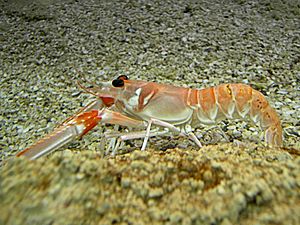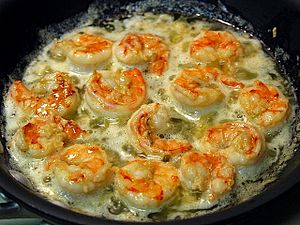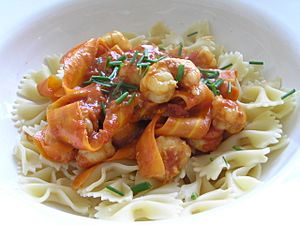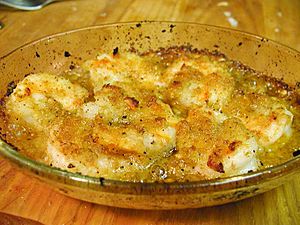Scampi facts for kids
Scampi, also called Dublin Bay Prawn or Norway Lobster (Nephrops norvegicus), is an edible lobster of the order Decapoda. It is widespread in the Mediterranean and northeastern Atlantic, from North Africa to Norway and Iceland, and is a gastronomic delicacy. Scampi is now the only surviving species in the genus Nephrops, after several other species were moved to the closely related genus Metanephrops.
Shrimp Scampi is a food that includes various culinary preparations of certain crustaceans, such as Metanephrops, as well as shrimp or prawns. Shrimp Scampi preparation styles vary regionally. The United Kingdom legally defines scampi specifically as Nephrops norvegicus. Monkfish tail was formerly sometimes used and sold as scampi in the United Kingdom, contravening the Fish Labelling (Amendment) England Regulation 2005 and Schedule 1 of the Food Labelling Regulations 1996.
Contents
Name
Scampi is the Italian plural of scampo, Nephrops norvegicus. The Italian word may be derived from the Greek καμπή kampē ("bending" or "winding").
Nephrops norvegicus
Norwegian lobsters are also known as Dublin Bay prawns, - the term prawn can be confusing as it is a vernacular or colloquial term that has no clearly defined scientific meaning - see Shrimp versus prawn.
The food labelling laws (in Britain, for example) define "scampi" as Nephrops norvegicus.
Preparation methods
According to the French encyclopaedia Larousse Gastronomique, langoustine are delicate and need to be poached only for a few seconds in court-bouillon. When very fresh they have a slightly sweet flavour that is lost when they are frozen. They can be eaten plain, accompanied by melted butter.
In Britain, the shelled tail meat is generally referred to as "scampi tails" or "wholetail scampi", although cheaper "re-formed scampi" can contain other parts together with other fish. It is served fried in batter or breadcrumbs and usually with chips and tartar sauce. It is widely available in supermarkets and restaurants and considered pub or snack food, although factors reducing Scottish fishing catches generally (such as bad weather) can affect its availability.
In the United States, "shrimp scampi" is the menu name for shrimp in Italian-American cuisine (the actual word for "shrimp" in Italian is gambero or gamberetto, plural gamberi or gamberetti). "Scampi" by itself is a dish of Nephrops norvegicus served in garlic butter, dry white wine and Parmesan cheese, either with bread or over pasta or rice, or sometimes just the shrimp alone. The term "shrimp scampi" is construed as a style of preparation, and with variants such as "chicken scampi", "lobster scampi" and "scallop scampi". Lidia Bastianich: "In the United States, shrimps are available, not scampi, so the early immigrants prepared the shrimp they found in the scampi style they remembered."
As an alternative seafood
Owing to the decline of fish stocks, British chefs including Heston Blumenthal and Hugh Fearnley-Whittingstall launched a "Fish Fight" campaign in 2010, attempting to raise awareness of alternative seafoods. They championed scampi and other lesser-known seafood dishes as a more sustainable source of protein.
National Shrimp Scampi Day
In the United States, National Shrimp Scampi Day occurs annually on April 29.
See also
 In Spanish: Scampi para niños
In Spanish: Scampi para niños





